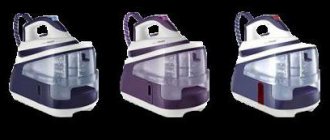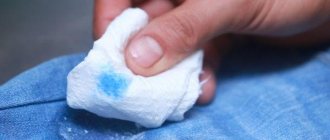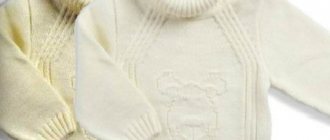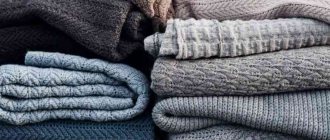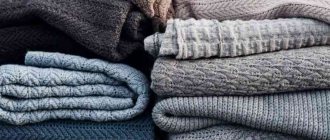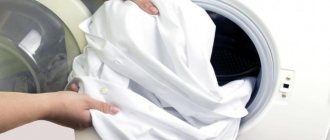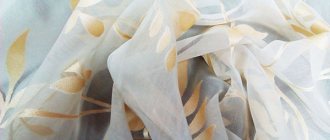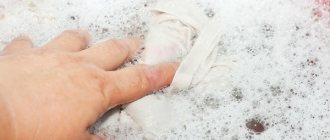Caring for clothes sometimes requires a lot of effort and takes a lot of time. A clothes steamer can be a great help with this.
A clothes steamer is an electrical device that produces steam heated to 98-99 degrees. Using a directed flow, steam penetrates the fabric fibers and aligns them without deforming the material. Thanks to the high temperature, disinfection occurs simultaneously with ironing.
How to use a steamer at home
Despite the fact that this newfangled device has been on the market for a long time, many do not quite understand how to use it, so they prefer to use an iron that is familiar to everyone.
Instructions for using the steamer:
- First you need to assemble the device and pour clean cold water into a special tank. How to assemble the unit and how to pour water into the steamer can be found in the instructions for use of a specific model.
- After a few minutes, a special indicator will let you know that the device is ready for use.
- It is necessary to direct the iron in the direction of the item opposite from you. Before starting work, you need to find out and adjust the intensity of the steam supply.
- Use a jet of steam from top to bottom several times until the area of fabric is completely smoothed.
Important! If you have no experience working with a steamer, it is advisable to test it on unwanted clothes to avoid damage to the material.
How to do it correctly
If you simply direct a stream of air from a hairdryer onto a wrinkled T-shirt or other clothing, nothing will happen.
You need to “iron” wet clothes with a hairdryer. The air stream should be powerful and hot. The hair dryer is kept at a distance of 10-15 cm.
It is best to start ironing immediately after washing the item, when it has dried a little. At the same time, you can dry it quickly.
Step-by-step instruction
There is nothing complicated about ironing clothes with a hairdryer. To get rid of wrinkles on clothes, follow the instructions:
- Place slightly damp clothing on a flat surface.
- If the fabric is dry, spray it with clean water from a spray bottle. You can simply spray water with your hands.
- Level the product as much as possible.
- Turn on the hair dryer at maximum power and temperature.
- Holding the device at a distance of 10-15 cm, blow on the fabric at a slight angle.
- Continue ironing (drying) the product until you are satisfied with the result.
It takes longer to describe a method than to put it into practice. Typically, ironing with a hairdryer takes no more than 10 minutes. Sometimes it is more profitable to resort to it than to use an iron. For example, when you need to iron tulle or a chiffon skirt (dress), a hair dryer copes with the task several times faster.
The principle of operation of the steam device
It’s easy to guess how a steamer works by its name. After turning on the device, the water in a special vessel is brought to a boil by a heating element, which maintains a constant temperature of the water. When you press the steam button, steam is released through a heat-resistant hose under controlled pressure. A variety of brush attachments will help you process different types of fabric. A huge advantage that distinguishes a steamer from an iron is that with it the fabric will not melt or get dirty.
Steamer from inside
Having figured out what type of steamer you want to purchase, you should also think about the “filling” of the device, because some types give more steam, while others less.
Here everything depends on the heating elements, which, according to the material of manufacture, can be steel or made of brass.
There is an opinion that brass as a material is more durable. But it is not so. The properties of this element are such that brass has less corrosion resistance, which does not affect the service life of the device.
Please note: Latest model steamers consist of a tank, pump, heater and valve. A simple mechanism provides steam, the power of which depends on the power of the heating element. In conclusion, a few more words about the configuration of steamers
In conclusion, a few more words about the configuration of steamers.
When buying, you should also pay attention to this. Almost all steamer models have the following equipment:
- brush,
- trouser clips,
- protective mitten,
- devices for collar and pocket steamers,
- clothes hangers that conveniently hold items in place for ironing.
If you are still in doubt about your choice, you can always ask the question you are interested in to the consultants in the stores.
Additional functions of the steamer
Of course, the set of additional functions will depend on the specific type of steamer, but we can highlight those that are provided in almost all models:
- High-quality smoothing of items of any size. Every housewife has encountered the difficulty of ironing massive curtains or outerwear. It takes a lot of effort to place the curtains on a miniature ironing board, especially to hang them in place and not wrinkle them again. In this case, a steamer is indispensable, since it can be used to process things in any convenient place: on hangers or on curtains.
- Contactless ironing method. A steamer, unlike an iron, will not burn the fabric when heated. Synthetics are especially susceptible to heat treatment. How to iron with a steamer of a specific model can be found in the instructions.
- Smoothing any type of fabric. A steamer will make the fluffy material fresher, while an iron would simply crush it. Clothes with any decorative elements (rhinestones, sequins, etc.) will not lose their appearance during processing, and the fabric underneath, which is inaccessible to the iron, can be easily straightened using a steamer.
- Cleaning fur products. With the help of directed steam, particles of dirt and dust on the fur fibers can be easily removed.
- Steam supply under pressure. This function will help not only smooth things out, but also carry out wet cleaning in the house, even in the most difficult to reach places.
Advantages over an iron
Ironing a shirt, regardless of the material it is made of, is sometimes a very tedious task, especially if there are not two or even three of them in your wardrobe. But you want to get all the work done at once, so that you don’t have to be distracted by the process of smoothing out wrinkles and creases throughout the next working week. What are the advantages of a steamer over an iron:
- irons many times faster and with better quality;
- you can easily iron hard-to-reach places;
- there is no need to suffer with creases on the sleeves and try to get rid of the “arrow”;
- removes small stains;
- does not leave shiny spots;
- is not able to leave a “burn” on the fabric;
- eliminates unpleasant odor.
Types of household steamers
Handheld or portable
This type of steamer is ideal for those who travel a lot or are on the go, as it is compact, quite lightweight and easy to store. The price for this model is lower than for a vertical steamer. But with all its advantages, it has several disadvantages:
- Suitable for one-time processing of only a small number of items, as it has a small water container.
- often has low power, so steaming will take longer than when working with other models.
Stationary or vertical
A vertical steamer is more powerful than a manual steamer.
It consists of a steam generator, a water tank, a hose and various attachments. Thanks to its power, it can quickly deal with any type of fabric, including outerwear and denim. It is vertical floor steamers that are used in cleaning companies and clothing stores. How to properly steam things with a vertical steamer:
- You should read the instructions for using the steamer.
- The height of the steamer is adjustable so that you can iron clothes without bending over.
- The fabric must be kept taut for best results.
- For smoothing shirt collars and cuffs, an elongated board, which often comes with a vertical steamer, is perfect.
- It is necessary to ensure that the steam supply hose does not bend, this will make the pressure less powerful.
You should choose a steamer based on the purpose of its use. For a family with children, it is better to choose a powerful floor steamer. For those who travel a lot or go on business trips, a hand-held, portable model will be the best assistant. A stationary steamer with good power is suitable for a clothing store, studio or cleaning company.
We recommend:
Clothes steamer - rating of the best models
Classification of steamers
According to their design and purpose, steamers come in various types, among which are:
- Hand steamer;
- Steamer with a vertical stand;
- Steam cleaners;
- Professional steamers.
The first type of steamer is manual, the simplest and most convenient to use. Low power and affordable price make it easy to use when traveling, where it is not possible to use an iron. Another feature of them is that they can be used as a small kettle to boil water on the go.
The first type of device has a tank, the volume of which is designed to steam clothes for 10-15 minutes. During this time, you will have time to iron two or three things from your suitcase.
Good steam, stylish design and small size are the main advantages of this category.
Most often, these steamers with a stand have only one mode, low power, a plastic iron, simple controls on the body and a relatively small tank volume. Also in this category, the equipment is modest and there is no possibility to add water at any time.
An important point: Steamers from the second subgroup already have higher power, which is why their effectiveness is an order of magnitude greater.
Powerful steam flow, control is already on the handle, which is more convenient. The metal iron in some models has an additional heating function. The large tank has the ability to add water. Another advantage of these senders is several modes that allow you to reduce and increase power. This feature is useful if you have fabrics that are sensitive to hot air in your wardrobe.
The third type includes steam cleaners. These are devices that combine two devices at once - a steamer and a steam cleaner. If you need sterile cleaning at home, then you cannot do without this “machine”. Hot steam helps bacteria disappear and various contaminants are cleaned away.
With such a steamer you can even clean off grease that has accumulated on the surfaces of the stove, mirrors, in the oven, or wash the tiled floor with a steam mop. This option is especially relevant in families with children.
The fourth type is professional devices, which are usually installed in stores, in the theater costume department, in clothing stores and other similar places. But, if desired, they can be installed at home.
Steamers of this type are characterized by high power, which allows them to work for a significant amount of time without interruption. The tank has a large volume, there are some functional parts for professional use, for example, a convenient frame hanger.
What can be ironed with a steamer?
The steamer can be used to process any items, including those that an iron cannot handle:
- lined items, outerwear;
- clothes with arrows. To do this, use special clamps, which often come with a steamer;
- things with decorative decorations (beads, embroidery, rhinestones, etc.);
- products with fur and pile;
- curtains - they can be ironed while hanging, without lowering them from the curtains;
- It can be used to disinfect toys, furniture, blankets and pillows.
Note! To process thin fabrics (silk, muslin, brocade), you need to reduce the steam power and test the operation of the device on a separate piece of fabric.
Tips for choosing
When going to a hardware store, you should pay attention to the control units. There are mechanical and electronic
With a mechanical control unit, the device is configured and adjusted manually. Electronically controlled models require pre-installation of all necessary parameters, which can be viewed on a special display. Although their price is much higher, they provide additional convenience and time savings.
Each of the steamers has its own technical characteristics, the main of which are power, tank volume, weight of the device, method of steam supply and the material from which it was made. Don’t lose sight of the additional functions that make the process of steaming and disinfecting fabrics even easier.
It is important not to strive to buy the latest new products, which after a short period of time cease to be so. The purchased item should please you with its quality and long service life
And you can increase it by following all the rules of proper operation.
Safety precautions when working
Since the steamer produces hot steam, before turning it on, be sure to study the safety rules:
- The steamer must only be used for its intended purpose; it must not be directed at people, animals or plants.
- You should not treat clothing on yourself or another person.
- Always keep the appliance switched on under supervision and away from children.
- It is forbidden to work with a damaged steamer. Doing repairs yourself is also not recommended. In the event of a breakdown, contact a specialist.
- Before starting work, you need to study the instructions on how to steam things with a steamer of a specific model.
- Before adding water to the container, the device is disconnected from the power supply. Use only clean and cold water, preferably distilled. It is prohibited to add soap, washing gels and powders to water.
- Lined items are handled in a special glove.
- In order to protect yourself from burns, the steamer is held in the opposite direction from you.
Additional Information! Often the vertical steamer makes bubbling sounds. Don't be scared! This happens due to the heating of the water in it.
Undoubtedly, a steamer is an indispensable device in everyday life, and once you try it, it is no longer possible to part with it. And in order not to make a mistake when choosing a model, you should definitely study the characteristics and reviews.
We help solve any difficulties...
Household chores take up a significant portion of your time. A whole series of household chores falls on fragile women's shoulders. To make this fate easier, we will tell you in detail how easy and simple it is to put a shirt made of natural cotton in order - to remove all the folds, unevenness and bruises.
Ironing is a special procedure that brings a lot of unpleasant troubles, which are not always possible to cope with. Now, take a breath and sit down to read this useful article that will help you find a hassle-free path.
To properly organize the process at home, we provide useful recommendations. This way you will replenish your reserves of skills, abilities and wisdom, and your man will be grateful to you for your care, warmth and comfort.
General recommendations for ironing outerwear
Outerwear is often made from synthetic materials. They are durable, wear-resistant, dirt does not linger on them, and cold air and moisture do not pass inside. But such fabrics react poorly to high temperatures. Therefore, ironing them with an iron is either not recommended at all, or the procedure must be carried out carefully.
The manufacturer's ironing recommendations will be indicated on the product label. Most often on outerwear you can find the following symbols:
- an iron icon without marks inside will indicate that ironing is allowed,
- one dot on the iron icon indicates that the product can be ironed with a low-heat iron,
- the crossed out iron icon prohibits ironing,
- The iron icon crossed out at the bottom indicates that steaming is prohibited.
Important: Be sure to pay attention to the symbols on the specific product label.
For example, on one item an icon indicating how to iron a polyester jacket will allow ironing with a low-heat iron, while another jacket made of the same polyester will not be allowed to be ironed.
How to iron a bologna jacket
Bologna jackets are very practical. This material is almost 100% waterproof. In order not to face the question of how to straighten a bolone jacket, after washing the product, it is recommended to shake it thoroughly and dry it in a straightened state.
If the problem of how to iron a bologna jacket has become urgent, it is recommended to steam the fabric. Vertical steamers come to the rescue. A powerful stream of steam effectively smoothes out any creases on clothes, while acting very delicately. Unlike irons with a steam function, the sole of vertical steamers does not come into contact with the material, so there is no risk of melting or burning the fabric.
How to iron a bologna windbreaker if you don’t have a steamer at hand? You can “walk” over the jacket with an iron, but be sure to place a clean cloth, for example, gauze folded in several layers, between the product and the sole of the iron.
Ironing a polyurethane jacket
Outerwear made of polyurethane, or eco-leather as it is also called, is wear-resistant and resistant to deformation. Having purchased such a thing, the question of how to iron a polyurethane jacket rarely arises. Usually it is enough to hang the product on hangers, fasten the buttons or zipper and let it hang for a while. Under the influence of its own weight, the jacket will level out. But sometimes this doesn’t work and unaesthetic creases remain on things. How to properly iron a polyurethane jacket?
Experienced people recommend the following method:
- take a clean cloth or paper, such as dry paper towels,
- stuff the sleeves of your jacket tightly with them,
- boil a saucepan of water,
- hang the product on hangers,
- Place the holder over the pan and fix it securely to prevent the jacket from falling into the water.
Under the influence of steam, the folds will straighten out. After this, do not remove the “filler” from the sleeves. Leave the item on the hanger until completely dry, and only then remove the paper or fabric.
Ironing a polyester jacket
Probably everyone has polyester jackets in their wardrobe. This material has a number of advantages that have given it such wide popularity:
- polyester is easy to wash and dries quickly,
- things made from it are resistant to pollution,
- polyester does not deform when washed,
- synthetic fabrics do not fade when exposed to sunlight,
- Polyester practically does not wrinkle.
If you get such a thing, you are unlikely to encounter problems in caring for it, since ironing a polyester jacket is extremely rare. Well, if such a need arises, we will tell you how best to iron a polyester jacket.
Steaming
The easiest way to smooth polyester is with a stream of steam. A household steamer will cope with this task in no time.
Recommendations for the steaming procedure:
- hang the jacket on hangers or a steam generator holder,
- if your steam generator has several operating modes, install the “Continuous steam supply” program,
- If there is a mode for processing delicate fabrics, select it,
- placing the steamer iron a few centimeters from the fabric, move it from top to bottom,
- It is recommended to first process the back of the jacket, then the sleeves, shoulders, the “face” of the product, and complete the process by processing the collar and hood.
Wait until the jacket is completely dry, and then hang it in the closet.
Ironing
You can also iron a polyester jacket with an iron, but you need to act extremely carefully:
- Manufacturers often sew a piece of material from which the item is sewn onto outerwear from the inside out; it can be used to select the temperature of the iron,
- if it was not possible to select the temperature in this way, always start ironing with minimal heat, no higher than 40 degrees,
- Do not hold the iron in one place for a long time, but quickly move it across the fabric.
It is safer to iron the item from the inside out. If the item is without insulation or the layer of filler is thin, it is better to iron the clothes turning them inside out. But this method is not suitable for winter clothes, since it will not be possible to iron a padding polyester jacket with thick filling this way. If you have to iron the jacket from the front side, place a damp, clean cloth under the soleplate of the iron.
How to iron a suede jacket?
Outerwear made of natural suede looks attractive. But such clothes cannot be called practical. Suede products require special care, as do genuine leather jackets. Experts recommend not to torment yourself with the question of how to iron a suede jacket. Do not risk the product, entrust it to professionals. If you can’t use dry cleaning services, we will share a way to iron a suede jacket at home.
This method works quite successfully in ironing various fabrics. Brides use this method to smooth out their wedding dress. Rest assured, your suede jacket will definitely perk up. Instructions on how to iron a suede jacket are as follows:
- fill the bathtub with as hot water as possible,
- hang the jacket on hangers and place it close to the bathtub,
- you can hang the hanger on the shower holder if you are sure of its reliability,
- Leave the suede jacket in a room filled with steam for at least a quarter of an hour.
After all the wrinkles on the outerwear have disappeared, dry the jacket well naturally.
Important: do not iron suede products under any circumstances! This can result in unsightly dents.
When purchasing new outerwear in a store, you can ask the consultant if they provide an ironing service. Many large stores offer to steam items for free. But even at home you can give your jacket a flawless look. The main thing is to follow the care recommendations described above. If you know effective ways to iron outerwear, share them in the comments at the end of the article.
A source of information
Steam generator and steamer
You can tidy up a cotton shirt not only by using an iron. A steam generator and a household steamer also give a good effect.
| Device | Application procedure |
| Steamer | Loose cotton used for shirts lends itself well to steaming. A directed jet of hot steam easily removes wrinkles on a shirt placed vertically. |
| Steam generator | Steaming is carried out with a jet of steam. A cotton shirt will straighten out under such influence, no matter how wrinkled it is. |
How to iron trousers so that the creases stay in place for a long time?
Persistent arrows are one of the signs of proper ironing. Such smooth and beautiful lines will characterize the hostess from the most pleasant side, which testifies to her skills. In order for the arrows to last long, it is important to follow the ironing rules.
Note! If corduroy products are processed, it is important to maintain a straight line. To do this, you need to gradually move the iron, moving in one direction, so as not to cause slipping.
In order for the arrows to be preserved for a long time, the procedure must be started from the level of the knees. With this approach, the central part will be outlined immediately, which will give an understanding of where to move next.
Let's look at a few tips to ensure long-lasting arrows:
| Recommendation | Description |
| Using aids | Some men and women use small pins to keep the wings straight. Such devices may cause damage to textiles. Before piercing the fabric in a visible place, test it where the punctures will not be visible |
| Application of acetic acid | Wet the gauze not in ordinary water, but in an acidified solution using a tablespoon of vinegar per 1 liter of water. This move will help make the arrows stable and sharp. |
| Laundry soap | Do you want to achieve long lasting wings without gauze? Try using a bar of laundry soap without fragrances or additives. Draw a clear stripe from the wrong side, then iron the trouser leg from the front side |
| Timing | Many people want to iron the product quickly, just before leaving the house. If you do this, the arrows will instantly spread out. To keep the tight lines for a long time, after ironing, you need to let the trousers cool slightly |
| Storage | Ironed trousers should be stored in the closet on a special hanger. It has a special design: it grabs the bottom of the trouser leg, leaving the waist part hanging down. In this case, the arrows of both trouser legs must be connected |
How to care for polyester items
With the development of technology, synthetic items have appeared in people's wardrobes. Polyester retains heat well and does not allow moisture to pass through, which is why this fabric is widely used in sewing demi-season jackets, raincoats and down jackets. To preserve the appearance for a long time, it is enough to follow the manufacturer’s recommendations for care and cleaning indicated on the label. To prevent fabric deformation, you should follow the rules for washing polyester clothes:
- To ensure that the front side retains its appearance, the item should be turned inside out before washing,
- wash only on delicate cycle,
- washing powder should be designed specifically for synthetic items,
- water temperature no more than 60 degrees, for some fabrics - no higher than 40 (at temperatures above 100 degrees the material will be damaged and deformed),
- the use of bleaches is not recommended,
- if spinning is used, then only at minimum speed,
- When rinsing by hand, you can add a little antistatic agent to the water to prevent dirt and dust from sticking to your clothes (if you don’t have it, you can use regular vinegar, diluting a few tablespoons in water).
If the fabric is too thin, it is advisable to wash it by hand without squeezing, rinse in warm water with the addition of table vinegar. Dry flat on hangers. With proper washing and spinning, items made of polyester and bologna do not need to be ironed; just hang them up and straighten them with your hands. If folds still form, then you need to iron polyester jackets carefully so as not to completely ruin the item.


